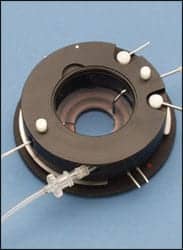
With its goal of providing the best and broadest solutions for the microbiology diagnostician, Trek Diagnostic Systems, which was founded in 1999, acquired the Cellenium automated urine screening system in October 2000. The system, part of Trek’s acquisition of Combact Diagnostic Systems, Ltd. of Israel, provides the first fully automated solution to this labor-intensive and technique-sensitive testing methodology.
The science behind Cellenium
Cellenium combines selective molecular fluorescence staining with computerized video image analysis to perform rapid urine screening. Using patented robotic operation, aliquots of each urine sample are dispensed into a cassette which also contains molecular stains. The cassette is then automatically coupled with a porous membrane. Vacuum filtration deposits a thin layer of stained microorganisms on the membrane, which is examined using computerized fluorescent microscopy imaging. The images are segmented, using a threshold algorithm, and the detected objects are classified by image analysis algorithms into biological and morphological type. The specimens are then screened positive or negative compared to predetermined thresholds: 104 and 105 CFU/ml.
“Cellenium is a multi-disciplinary system made possible through the concerted effort of biologists, algorithm experts, electronics and computer engineers,” said Eli Sahar, Ph.D., developer of the Cellenium system. “Its sophistication is evidenced by the eight years and $35 million dollars invested in its development.”
Efficiency through automation
Automating diagnostic testing has been a goal of microbiology laboratory managers for more than a decade. Blood culture detection, bacterial identification and antimicrobial susceptibility testing have been semi-automated for years, but until Cellenium, there has been no reliable and reproducible fully automated method for urine screening that provides rapid, quantitative results.

Cellenium provides a level of automation comparable to the blood chemistry analyzer – arguably the standard in automated laboratory testing. Once patient urine specimens are received in the laboratory, they are barcoded and entered into the Cellenium system. Cellenium is designed to analyze fresh or refrigerated specimens as well as specimens containing a preservative such as boric acid. Specimens are placed into a Cellenium tray designed to accommodate standard urine collection tubes. Cellenium can stage up to 90 specimens, loaded in up to three trays of 30 specimens each.
Once the trays are loaded, the laboratory staff is free to address other duties. Results are available in 30 minutes with throughput of up to 70 specimens per hour. To maximize throughput, Cellenium is capable of batch or continuous feed operation.
Sensitive screening
During clinical trials at the University of California at Irvine (UCI), 890 randomly selected midstream and catheterized specimens were analyzed. When compared to the reference (standard urine culture methodology) at >104 CFU/ml, the sensitivity and predictive value negative of the Cellenium were 92% and 96%, respectively. The Cellenium sensitivities increased to 98% and 99%, respectively, when compared to 5×104 and 105 CFU/ml. At >104 CFU/ml, the Cellenium detected 96% (189 of 197) of the gram-negative bacilli (GNB), 78% (76 of 97) of the gram-positive cocci (GPC) and 80% (12 of 15) of the yeast. Of the 32 isolates not detected by the Cellenium, 69% (22) had <5×104 CFU/ml.
In evaluating Cellenium’s capability to use the Gram classification as a urine screen, it detected 100% of the GNB and 96% of the GPC when the isolate was present as a pure culture.
“The Cellenium proved to be a sensitive urine screen and also offers complete automation, ease of operation, rapid test results and the ability to test multiple samples,” said Marie T. Pezzlo, administrative director, department of pathology at UCI and principal clinical trial investigator.
Results from the clinical trial at the Mayo Clinic in Minneapolis were similar.
“The ability of the Cellenium to detect 104 CFU/ml was outstanding. Our calculations showed that the sensitivity for detecting bacterial and yeast pathogens at 105 CFU/ml was 99.4% and at 104 CFU/ml was 98.1%,” said Franklin R. Cockerill, M.D., chair, division of clinical microbiology at the Mayo Clinic. “In my review of the medical literature, these results are unique. No other screening methods perform as well as Cellenium for detecting significant bacteriuria or candiduria.”
Custom data analysis and reporting
Cellenium’s Windows NT-based operating system reports results in several ways. Images are automatically stored in the system and are available for review. Positives and negatives are color-coded on the graphical map to direct laboratorians to the positive specimens that require culture.
The result form includes specimen identification, concentration, Gram classification and morphology of bacteria, if present in the specimen. If yeast or WBC are detected, their presence in the sample will be flagged.
The system’s report wizard accesses and sorts test results according to specimen identification and/or test date. Test results may be stored on the Cellenium computer system for a minimum of 30 days; communication to an LIS will be supported.
Rapid turnaround time
Unlike any other urine screening system, Cellenium is designed to detect, enumerate and classify pathogenic microorganisms (bacteria and yeast) and white blood cells in urine within 30 minutes. This rapid categorization eliminates the requirement to culture negative specimens and provides the ability to report negative results one or two days earlier than the traditional culture method.
“Cellenium offers advantages not currently available in other urine screen systems,” according to Gary Procop, M.D., section head of the microbiology department at the Cleveland Clinic Foundation and a clinical trial participant. “It offers quantitation and Gram stain morphologic information which may be used to more appropriately tailor patient therapy.”
Trish Rooney is a freelance writer based in Cleveland, Ohio.
For more information, contact Trek Diagnostic Systems Inc. at 1-800-871-8909 or www.trekds.com .



